Guide to Cool-Season Grasses
BY MEL CHILDS | AUGUST 1ST, 2023 | BLOGNot all grass is the same. There are variations in grass types across the country, which can affect the best way to care for your lawn. If you live in the northern part of the U.S., you likely have a cool-season grass type growing in your yard. What does that mean? This cool-season grass growing guide will teach you about these grass types and the best ways to maintain them.
In this guide:
- What Are Cool-Season Grasses?
- Where Cool-Season Grasses Grow
- Cool-Season Grasses vs. Warm-Season Grasses
- Types of Cool-Season Grass
- Lawn Care for Cool-Season Grasses
- Maintenance Calendar For Cool-Season Grasses
- FAQ
What Are Cool-Season Grasses?
Cool-season grasses are grasses that grow mostly in the spring and fall in the northern regions of the U.S. These grasses include tall fescue, fine fescue, Kentucky bluegrass, and perennial ryegrass. They grow and thrive during cooler temperatures between 60 to 75 degrees, and they withstand extremely cold temperatures well.
Cool-season grasses are perennials. Therefore, they will come back year after year if they are cared for properly. Although they thrive in cool regions, some of these grasses are also drought-tolerant and can thrive in hotter regions. However, when it is hot, they tend to become dormant until the weather cools. Sometimes, they develop lawn diseases in extreme heat and drought.
Where Cool-Season Grasses Grow
Most cool-season grasses are native to northern regions of the U.S. See the map below to find out if you live in the cool-season grass growing zone, the warm-season grass growing zone, or the transition zone, where both cool-season and warm-season grasses can thrive.
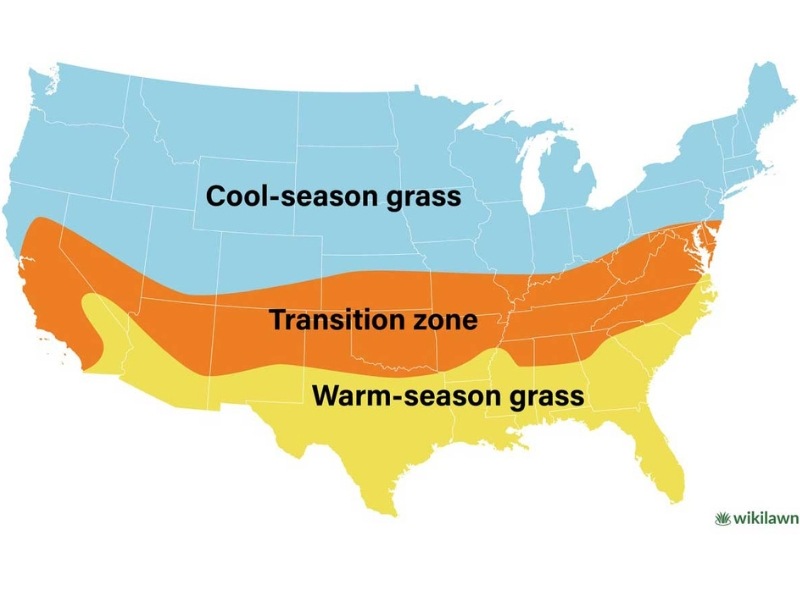
Illustration by Juan Rodriguez
Here are some states where you can expect cool-season grasses to grow:
- Connecticut
- Delaware
- Idaho
- Iowa
- Maine
- Maryland
- Massachusetts
- Michigan
- Minnesota
- Montana
- Nebraska
- New Hampshire
- New Jersey
- New York
- Ohio
- Pennsylvania
- Rhode Island
- South Dakota
- Vermont
- Virginia
- Utah
- Washington
- Wisconsin
- Wyoming
If you reside in one of these states, you most likely have cool-season grass growing in your yard. For more help identifying the grass your lawn is made of, you can contact your local Cooperative Extension Office.
Cool-Season Grasses vs. Warm-Season Grasses
As you already know, cool-season grasses thrive in areas where the temperatures are much cooler throughout the year. Warm-season grasses, on the other hand, grow best in hot summer temperatures, so they tend to grow in the South.
Warm-season grasses grow most actively in temperatures from 75 to 95 degrees. They become dormant below 55 degrees. Popular warm-season grasses include centipedegrass, Bermudagrass, Zoysiagrass, St. Augustinegrass, and Bahiagrass.
Types of Cool-Season Grass
The most popular cool-season grass types for lawns in the northern U.S. include:
Tall Fescue
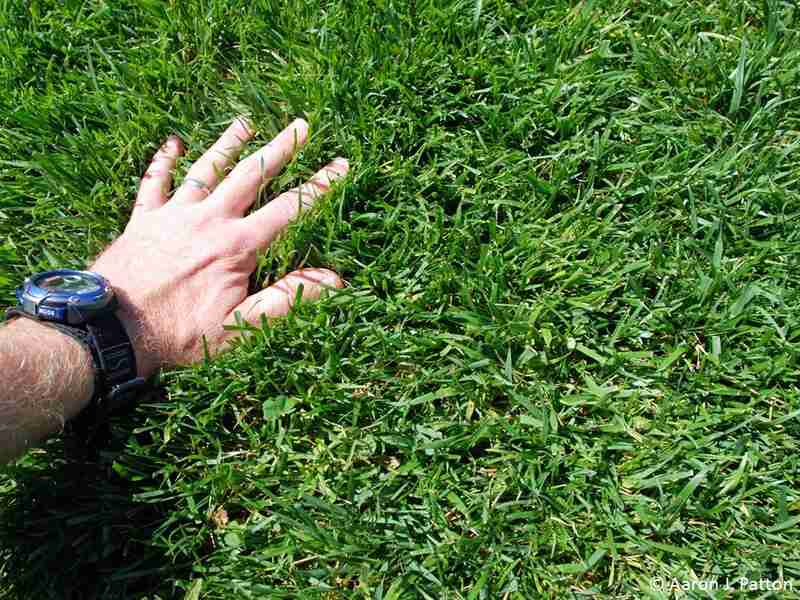
Photo Credit: Aaron Patton / Purdue’s Turfgrass Science Program
If your grass is a medium to dark green color and grows out of the ground as a wide blade that ends at a point, like a ribbed sword, it is likely you have tall fescue grass growing in your yard. It is a very coarse grass that grows in bunches.
This grass type can handle drought and foot traffic well, but it is a high-maintenance grass. While it may not need fertilizer and water as much as other cool-season grasses, it will require frequent mowing because it grows pretty fast.
- Classification: Cool-season
- Potential for disease: Low
- Shade tolerance: Moderate; prefers direct sunlight
- Drought tolerance: Moderate
- Foot traffic tolerance: Moderate
- Maintenance needs: Fast rate of growth; prepare to mow often
- Mowing height: 3 to 4 inches
- Spreads by: Bunch-type grass
Fine Fescue
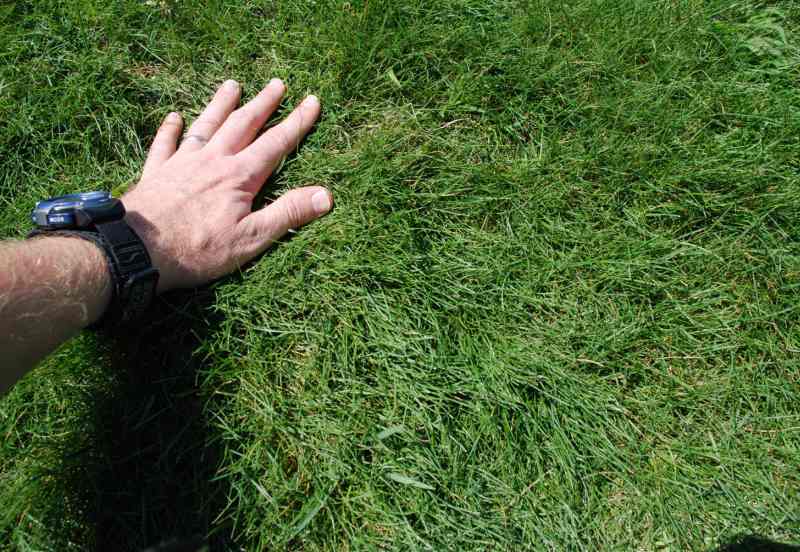
Photo Credit: Aaron Patton / Purdue’s Turfgrass Science Program
When you have fine fescue growing on your lawn, you know it because it is a slender, green-bladed grass type that tends to wilt as it grows. It is not grass that sticks upward like tall fescue. Because it is much thinner, it has a low tolerance for foot traffic.
On a brighter note, this grass can tolerate drought well, and you may see fine fescue in the transition zone. Another excellent quality is that this particular grass doesn’t require mowing as often as other cool-season grasses. There are four common types of fine fescue, including creeping red fescue, Chewings fescue, hard fescue, and sheep fescue.
- Classification: Cool-season
- Potential for disease: Moderate; can develop diseases like snow mold and red thread
- Shade tolerance: Moderate to high; requires at least four hours of sunlight per day
- Drought tolerance: High
- Foot traffic tolerance: Low
- Maintenance needs: Low
- Mowing height: 2.5 to 3 inches
- Spreads by: Bunch-type grass, except for creeping red fescues, which have rhizomes
Kentucky Bluegrass
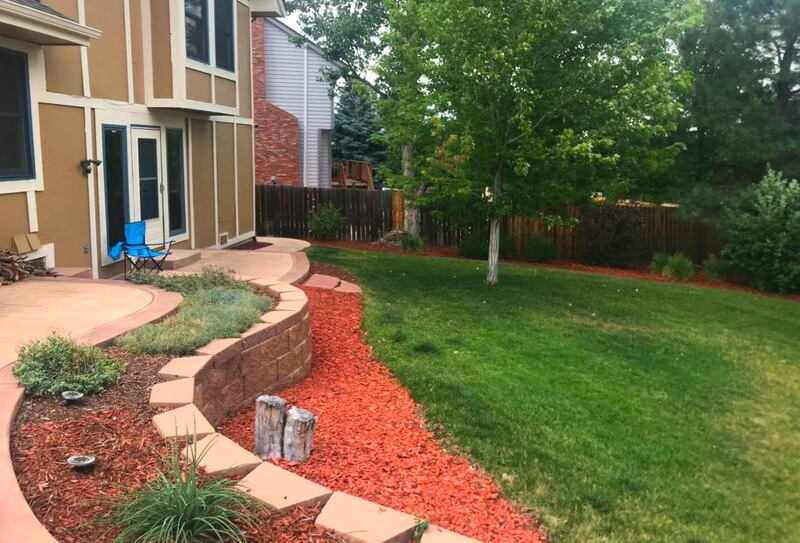
Photo Credit: Brenda Ryan / Wikilawn
When observing your grass, if you notice that it has a moderate to dark green hue and is a thin blade with a canoe shape, you probably have Kentucky bluegrass. This grass is sturdy and can grow well in the transition zone. But it will go dormant when temperatures rise above 70 degrees Fahrenheit.
This type of grass can tolerate high foot traffic, making it great for recreational use. However, it is also high maintenance since it needs frequent mowing and lots of irrigation.
- Classification: Cool-season
- Potential for disease: Moderate to high
- Shade tolerance: Moderate; likes full sun
- Drought tolerance: Moderate
- Foot traffic tolerance: High
- Maintenance needs: High
- Mowing height: 2.5 to 3.5 inches
- Spreads by: Rhizomes
Perennial Ryegrass
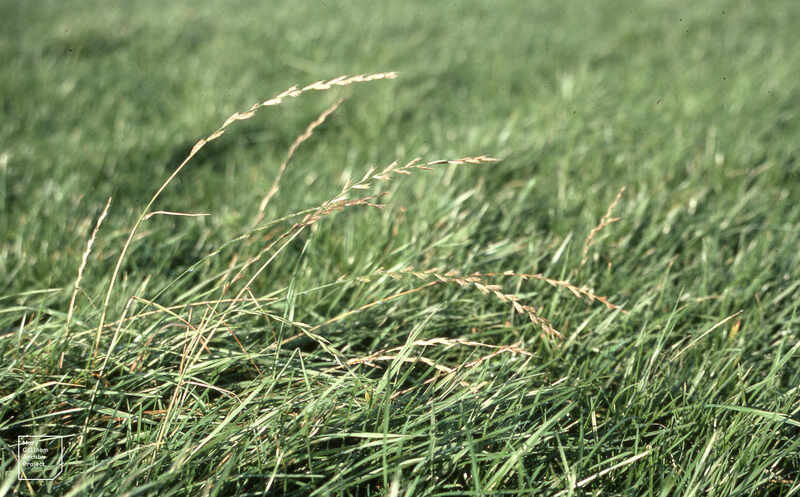
Photo Credit: Dr Mary Gillham Archive Project / Flickr / CC BY 2.0
If you have perennial ryegrass growing in your yard, it tends to be pale green in color and is slender in shape and pointed as it grows. One of its best qualities is that it can stand plenty of foot traffic. It is often combined with Kentucky bluegrass.
This grass type will require lots of cutting and irrigation. It will also need plenty of sun.
- Classification: Cool-season
- Potential for disease: High
- Shade tolerance: Low, needs full sun
- Drought tolerance: Low, will go dormant in summer
- Foot traffic tolerance: High
- Maintenance needs: High, requires frequent cutting
- Mowing height: 1.5 to 2.5 inches
- Spreads by: Bunch-type grass
Lawn Care for Cool-Season Grasses
So, you’ve determined that you have one of the common cool-season grasses on your lawn. That’s a great first step in improving your lawn’s health! Knowing your grass type means you can tailor your lawn care practices to your grass’s specific needs.
Here are some ways to keep your cool-season grass healthy and ensure a green lawn.
Irrigation
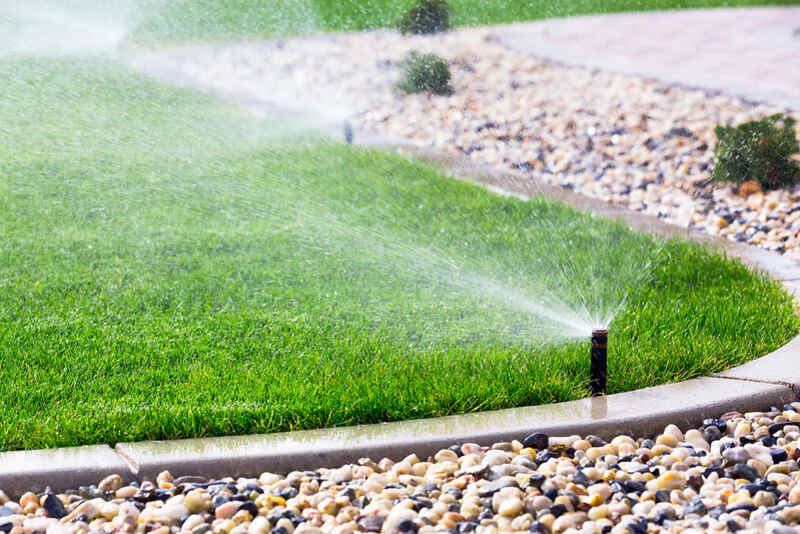
Photo Credit: Aqua Mechanical / Flickr / CC BY 2.0
When it comes to watering cool-season grasses, it is ideal to water less often for longer periods so that the water can penetrate the root system. Deep irrigation once a week, ensuring that the grass gets about 1 to 1.5 inches of water, is ideal.
Only water the grass when temperatures are above 40 degrees Fahrenheit to minimize the chances of water freezing on the grass blades. Also, water the grass in the morning, preferably before 8 a.m., as watering in the middle of the day leads to excess evaporation, and evening watering may encourage the growth of lawn diseases.
Keeping up with a proper lawn irrigation schedule – especially if you want to water the lawn early in the morning before you typically wake up – can be much easier if you install an in-ground lawn sprinkler system with an automatic timer.
Fertilization
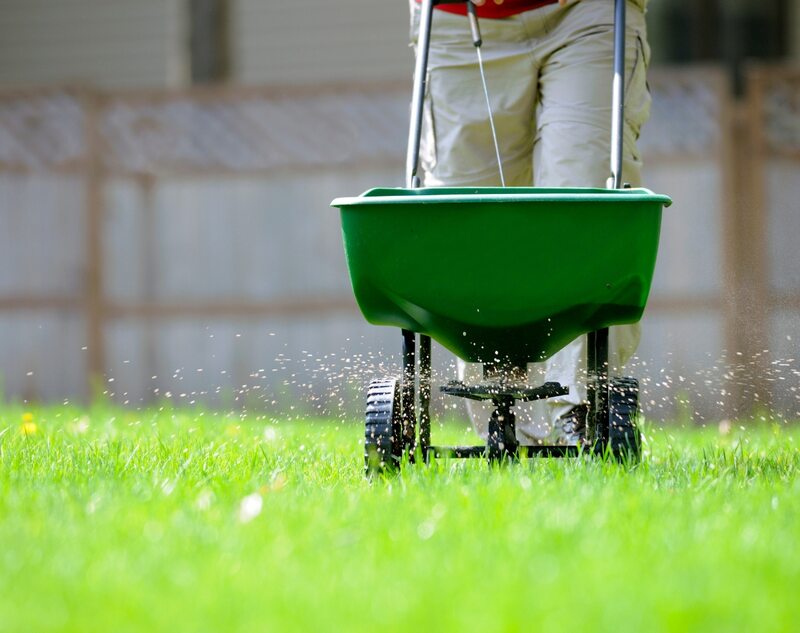
Photo Credit: groveb / Canva Pro / License
Nature provides a majority of what cool-season grasses need to thrive. However, fertilizers can help make your lawn healthier and protect it. Not all fertilizers are the same, however. You must choose the right one for your cool-season grass.
It is ideal to fertilize your lawn at least once a year, preferably in the fall. Overfertilizing your grass can damage it or even kill it, especially if you fertilize in the middle of summer when your cool-season grass is dormant.
Aeration
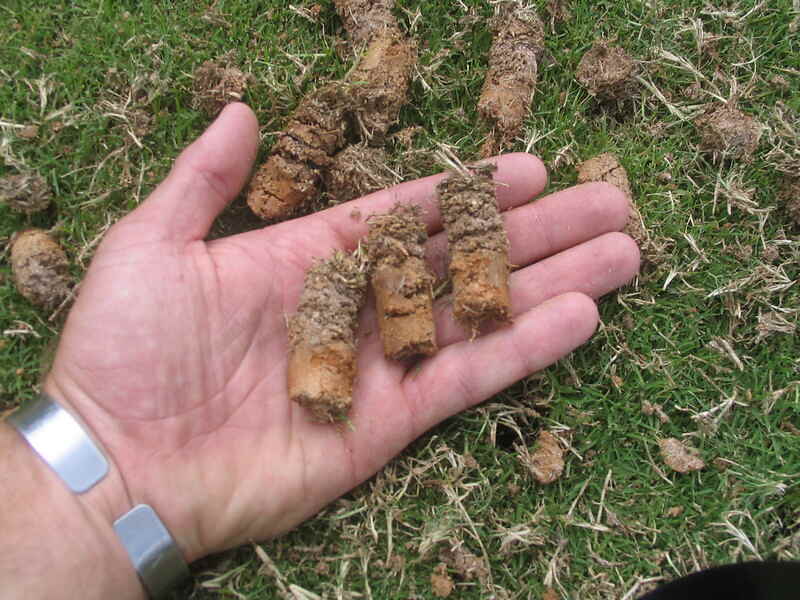
Photo Credit: Oregon State University / Flickr / CC BY-SA 2.0
When growing cool-season grasses, lawn aeration is also important. This is the process of taking a spike or plug aeration tool and sticking it into the soil to loosen up compacted soil. Aeration allows fresh air, nutrients, and water to penetrate deeper into your grass for better health and growth.
You’ll only need aeration once a year, if that, and it should be done in the fall for cool-season grasses.
Dethatching
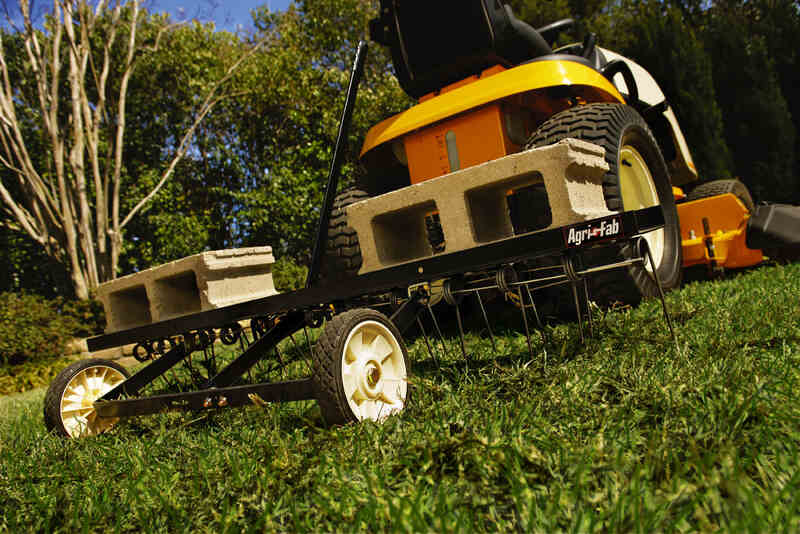
Photo Credit: Agri-Fab / Wikimedia Commons / CC0
Over time, as you water, mow, and fertilize your grass, a small layer of dead and living organic matter called thatch will develop close to the soil. This can make it difficult for water and nutrients to penetrate through the soil to your grass’s roots and can also attract lawn pests.
If this thatch buildup becomes more than one inch thick, it is time to dethatch your lawn using a dethatching rake or mechanical dethatching tool. Cool-season grasses should be dethatched in fall during their most active growth period.
Mowing
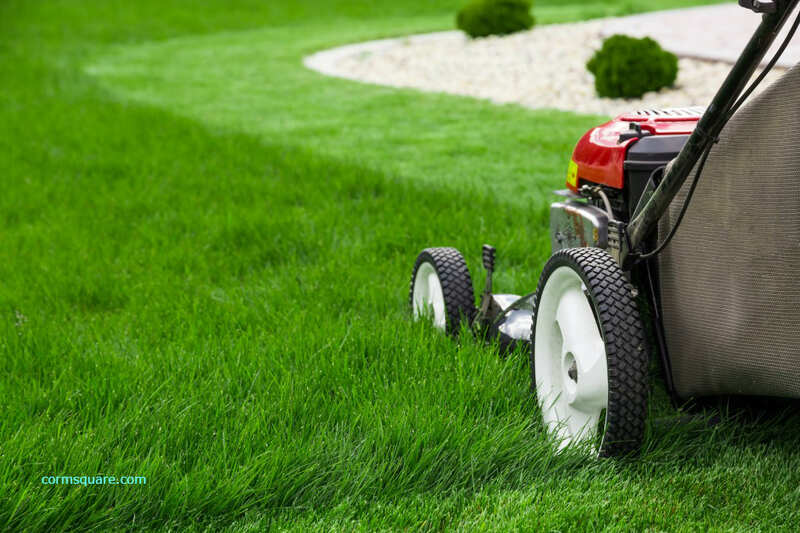
Photo Credit: Prasannanossam3 / Wikimedia Commons / CC BY-SA 4.0
Mowing will vary according to the type of cool-season grass you have in your yard or want to plant. Fine fescue doesn’t require mowing as often as other cool-season grass types. When mowing your grass, make sure that you avoid cutting more than one-third of its height at once.
Cool-season grass will grow the fastest and need the most frequent mowing in spring and fall. In summer, it’s best to allow your cool-season grass to grow as long as you’re willing to. Longer grass means deeper roots, which means increased drought tolerance. Tall grass also shades the soil and helps it retain water, which is crucial for cool-season grasses in the summer heat.
For best results, ensure that your mower’s blades are sharp to keep the grass from becoming vulnerable to disease and pests. Additionally, make sure the lawn mower blades are clean after previous clippings so that you won’t inadvertently spread disease around the yard from infected blades.
Disease Treatment and Pest Control
Diseases and pests are two destructive elements that can attack cool-season grasses. Keep in mind there isn’t a one-size fits all process for eliminating disease or pests from your grass. You must identify the specific pest or disease destroying your grass to ensure you use the right fungicide or insecticide. Otherwise, the treatment won’t be effective at all.
Weed Control
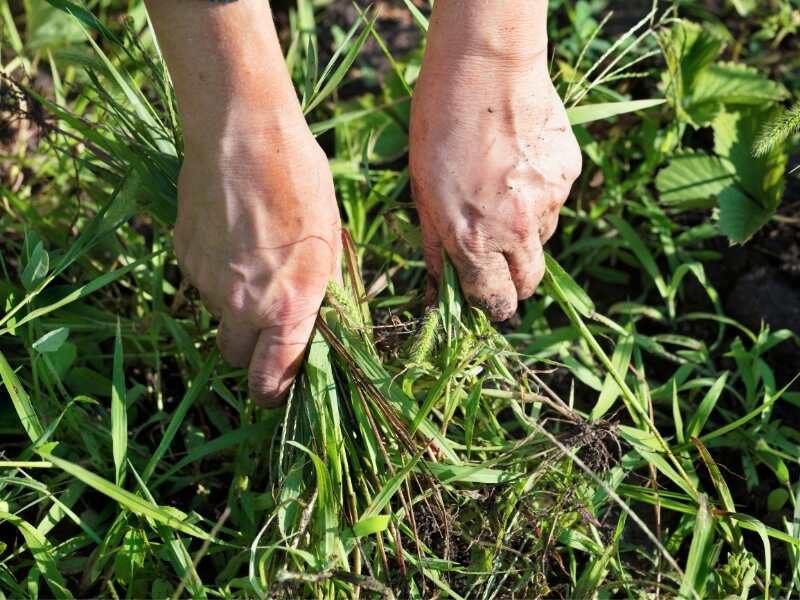
Photo Credit: Sergii Petruk / Canva Pro / License
Another problem you may encounter is weeds. Unfortunately, they can compete with your cool-season grass for resources. Some of the most common lawn weeds affecting cool-season grasses include but are not limited to the following:
- Carpetweed
- Chicory
- Crabgrass
- Curly Dock
- Dandelion
- Henbit
- Knotweed
- White Clover
To eliminate these weeds, you’ll have to make sure you treat them properly. Treatments include pre-emergent and post-emergent herbicides.
Pre-emergent Herbicides
These types of herbicides will block weeds from growing in your yard. They prevent weeds from growing by interrupting the growth process at the start. Ideally, it’s good to use such herbicides when temperatures are between 50 and 55 degrees Fahrenheit outdoors. Pre-emergent herbicides will do nothing to stop weeds that are already growing in your yard.
Post-emergent Herbicides
These types of herbicides are used to treat weeds that are currently growing in your yard. They may be liquid or granular. It is critical that you use such herbicides when it is less than 85 degrees Fahrenheit outdoors. Following manufacturer guidelines for application is best.
Overseeding
Damage to your grass can be corrected when you overseed your lawn. This is the process of spreading grass in bare spots to encourage a healthier lawn.
If you have recently had a disease on your lawn or you have damaged your grass with fertilizer, adding grass seed helps fill in the thinning grass. For cool-season grasses, overseed in fall at least 45 days before the first frost.
Maintenance Calendar For Cool-Season Grasses
Find specific lawn care tips for every season in this cool-season lawn maintenance calendar.
Spring
- Pest control: Grub worms can be a nuisance in the spring. If you see signs of grub worms around this time, apply an insecticide specially formulated for removing them. See our guide on how to get rid of grub worms to learn more.
- Soil testing: Spring is also a great time to test and improve your soil to help the grass prepare for the new growing season. Ensuring your cool-season grass has all the right nutrients will help it survive the upcoming heat of summer.
- Weed control: In spring, you should also apply a pre-emergent herbicide to minimize the growth of weeds during the growing season.
- Lawn mowing: Rake away any remaining leaves from last fall and start to mow your lawn according to recommended heights for your particular cool-season grass (see above).
Summer
- Water appropriately: Now is the time to pay close attention to rainfall levels. If your lawn isn’t getting as much water as it needs from rainfall, consider watering the grass yourself to minimize drought, which can be catastrophic for cool-season grasses.
- Weed control: For any summer annual weeds growing in your lawn, apply a post-emergent herbicide.
- Mulch your grass clippings: Allow grass clippings to remain on the lawn instead of bagging them. These clippings will break down into the soil, improving the soil texture and helping to retain water.
- Raise mower height: In summer, raise your mower blades and allow your grass to remain longer to help it survive the heat.
Fall
- Seed or overseed: Fall is the best time to plant cool-season grasses, so this is when you should overseed your lawn. If you’re establishing a new cool-season lawn, fall is also the best time to plant seeds or sod.
- Fertilize: Fall is the best time to fertilize your cool-season lawn, but make sure you do so at least 45 days before the first frost. Fertilizing once a year in the fall may be all you need. However, the next best time to fertilize, if multiple applications are necessary, is in early spring.
- Weed control: Apply a pre-emergent herbicide in the fall to prevent winter annual weeds
- Rake leaves regularly: Rake your lawn regularly to prevent a buildup of fallen leaves. Too many leaves can smother the grass and inhibit its growth.
- Dethatch and aerate: Fall is the best time to dethatch and aerate cool-season grasses. The best practice is to dethatch the lawn before you aerate it to give the aeration tool better access to the soil.
Winter
- Stop cutting the lawn: Even cool-season grasses go dormant in the dead of winter, so you can stop mowing them once they stop growing.
- Avoid foot traffic: Ice or frost may develop on your grass in winter. Therefore, try to minimize foot traffic to keep from damaging grass.
- Go easy on the de-icing salts: Keep de-icing salts from getting on your lawn, as they can damage the grass in its fragile dormant state.
- Winterize equipment: Before the onset of freezing temperatures, winterize your lawn care tools, such as your mower. You should also winterize your sprinkler system if you have one to prevent damage over the winter.
FAQs About Cool-Season Grasses
Can Cool-Season Grasses Grow in Warm Regions?
Cool-season grasses prefer the cooler regions of the Northern U.S. However, it is possible for cool-season grasses to grow in warmer climates in the transition zone.
Kentucky bluegrass is a cool-season grass that can grow in warmer regions. If it gets too hot for this grass to grow, dormancy will set in.
When Can I Expect Cool-Season Grasses to Go Dormant?
For cool-season grasses, the dormant period typically begins in winter when temperatures dip below 45 degrees Fahrenheit for the year. In northern regions, this can be in the fall.
Cool-season grasses may also go dormant in summer if the temperatures stay above about 90 degrees Fahrenheit. If this happens, the grass will turn brown to conserve energy, but it will spring back to life come cooler weather.
If I Want to Plant a Different Type of Cool-Season Grass in My Yard, When is a Good Time to Plant It?
The best time to plant cool-season grasses is in the early fall when temperatures are between 50 and 65 degrees Fahrenheit.
Get A Local Expert to Help With Your Cool-Season Grass
If maintaining grass isn’t your favorite thing to do, consider hiring a local lawn care pro who will help maintain a healthy lawn and keep it vibrant throughout the growing season. Local pros will know how to deal with all kinds of cool-season grasses, including the specific type in your yard.
Main Image Credit: mccawleyphoto / Canva Pro / License